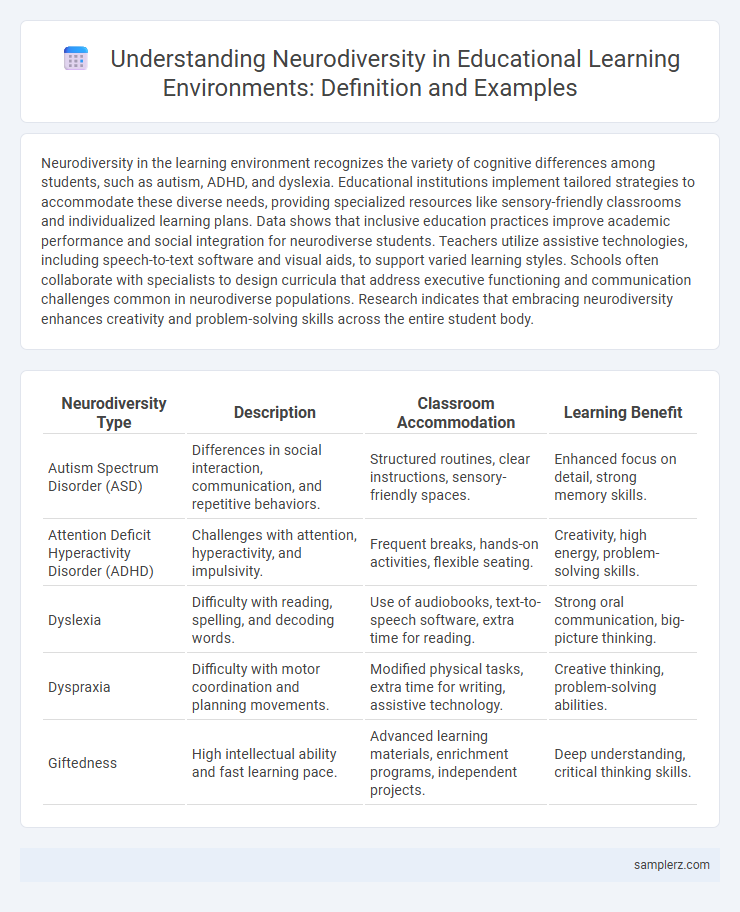Neurodiversity in the learning environment recognizes the variety of cognitive differences among students, such as autism, ADHD, and dyslexia. Educational institutions implement tailored strategies to accommodate these diverse needs, providing specialized resources like sensory-friendly classrooms and individualized learning plans. Data shows that inclusive education practices improve academic performance and social integration for neurodiverse students. Teachers utilize assistive technologies, including speech-to-text software and visual aids, to support varied learning styles. Schools often collaborate with specialists to design curricula that address executive functioning and communication challenges common in neurodiverse populations. Research indicates that embracing neurodiversity enhances creativity and problem-solving skills across the entire student body.
Table of Comparison
| Neurodiversity Type | Description | Classroom Accommodation | Learning Benefit |
|---|---|---|---|
| Autism Spectrum Disorder (ASD) | Differences in social interaction, communication, and repetitive behaviors. | Structured routines, clear instructions, sensory-friendly spaces. | Enhanced focus on detail, strong memory skills. |
| Attention Deficit Hyperactivity Disorder (ADHD) | Challenges with attention, hyperactivity, and impulsivity. | Frequent breaks, hands-on activities, flexible seating. | Creativity, high energy, problem-solving skills. |
| Dyslexia | Difficulty with reading, spelling, and decoding words. | Use of audiobooks, text-to-speech software, extra time for reading. | Strong oral communication, big-picture thinking. |
| Dyspraxia | Difficulty with motor coordination and planning movements. | Modified physical tasks, extra time for writing, assistive technology. | Creative thinking, problem-solving abilities. |
| Giftedness | High intellectual ability and fast learning pace. | Advanced learning materials, enrichment programs, independent projects. | Deep understanding, critical thinking skills. |
Understanding Neurodiversity in Educational Settings
Understanding neurodiversity in educational settings involves recognizing and valuing the diverse cognitive profiles of students, including those with autism, ADHD, dyslexia, and dyspraxia. Educators implement tailored teaching strategies that accommodate varied learning styles, such as multisensory instruction and flexible assessment methods. Promoting an inclusive environment enhances student engagement, reduces stigma, and supports academic success for neurodiverse learners.
Common Types of Neurodivergence Among Students
Common types of neurodivergence among students include autism spectrum disorder (ASD), attention deficit hyperactivity disorder (ADHD), dyslexia, and dyspraxia, each affecting learning in distinct ways. These neurodivergent conditions often require tailored instructional strategies, such as multisensory learning for dyslexia or structured routines for students with ASD. Incorporating universal design for learning (UDL) principles enhances accessibility and supports diverse cognitive profiles in educational settings.
Real-Life Examples of Neurodiverse Learners
Neurodiverse learners such as those with ADHD, dyslexia, and autism spectrum disorder often thrive in classrooms that implement tailored instructional strategies like multisensory learning and flexible seating. For instance, a student with dyslexia benefits significantly from audio books and text-to-speech technology, enhancing reading comprehension and engagement. Schools adopting Universal Design for Learning (UDL) frameworks report improved academic outcomes and increased participation among neurodiverse populations.
Inclusive Teaching Strategies for Neurodiverse Classrooms
Inclusive teaching strategies in neurodiverse classrooms include using multisensory learning techniques, such as combining visual, auditory, and kinesthetic activities to cater to diverse cognitive processing styles. Implementing flexible assessment methods, like oral presentations and project-based evaluations, supports students with varying communication and executive functioning abilities. Creating structured routines and providing clear, concise instructions help students with attention and sensory processing challenges thrive academically.
Adapting Curriculum for Neurodiverse Needs
Adapting curriculum for neurodiverse needs involves integrating multisensory teaching methods and flexible assessment formats to accommodate diverse cognitive processing styles. Personalized learning plans utilize strengths-based approaches to support students with autism, ADHD, and dyslexia, enhancing engagement and comprehension. Incorporating assistive technologies and differentiated instruction fosters inclusive classrooms that promote equitable educational outcomes.
The Role of Assistive Technology in Supporting Neurodiversity
Assistive technology plays a crucial role in supporting neurodiversity by providing personalized learning tools that accommodate diverse cognitive needs, such as speech-to-text software for students with dyslexia and visual schedules for those with autism. These technologies enhance engagement and accessibility, allowing learners to process information in ways that align with their unique cognitive profiles. Implementing assistive tools in educational settings promotes inclusivity and improves academic outcomes for neurodivergent students.
Challenges Faced by Neurodiverse Students in Schools
Neurodiverse students often face challenges such as sensory overload, difficulty with traditional teaching methods, and social communication barriers in learning environments. These obstacles can lead to increased anxiety, reduced academic performance, and feelings of isolation. Schools must implement inclusive strategies, such as differentiated instruction and sensory-friendly spaces, to support neurodiverse learners effectively.
Creating a Supportive Environment for Diverse Learners
In a neurodiverse learning environment, implementing personalized teaching strategies such as multisensory instruction and flexible seating arrangements enhances engagement for students with ADHD, autism, and dyslexia. Incorporating assistive technologies like speech-to-text software and visual schedules supports diverse cognitive needs and promotes independence. Professional development for educators on neurodiversity awareness ensures inclusive practices that foster a supportive atmosphere for all learners.
Success Stories: Neurodiversity Thriving in Education
Students with autism spectrum disorder (ASD) and attention deficit hyperactivity disorder (ADHD) have demonstrated remarkable success in inclusive classrooms that incorporate tailored teaching strategies and sensory-friendly environments. For instance, a university in California reported a 40% increase in graduation rates among neurodiverse students following the implementation of specialized mentorship programs and flexible assessment methods. These success stories highlight the crucial role of personalized support in unlocking the potential of neurodiverse learners within education systems.
The Benefits of Embracing Neurodiversity in Learning
Embracing neurodiversity in learning environments enables tailored teaching strategies that accommodate diverse cognitive profiles such as autism, ADHD, and dyslexia, enhancing engagement and academic outcomes. Inclusive classrooms foster creativity and problem-solving by integrating varied perspectives and learning styles, benefiting both neurodivergent and neurotypical students. Educational institutions that prioritize neurodiverse approaches report improvements in student confidence, collaboration, and overall well-being.

example of neurodiversity in learning environment Infographic
 samplerz.com
samplerz.com